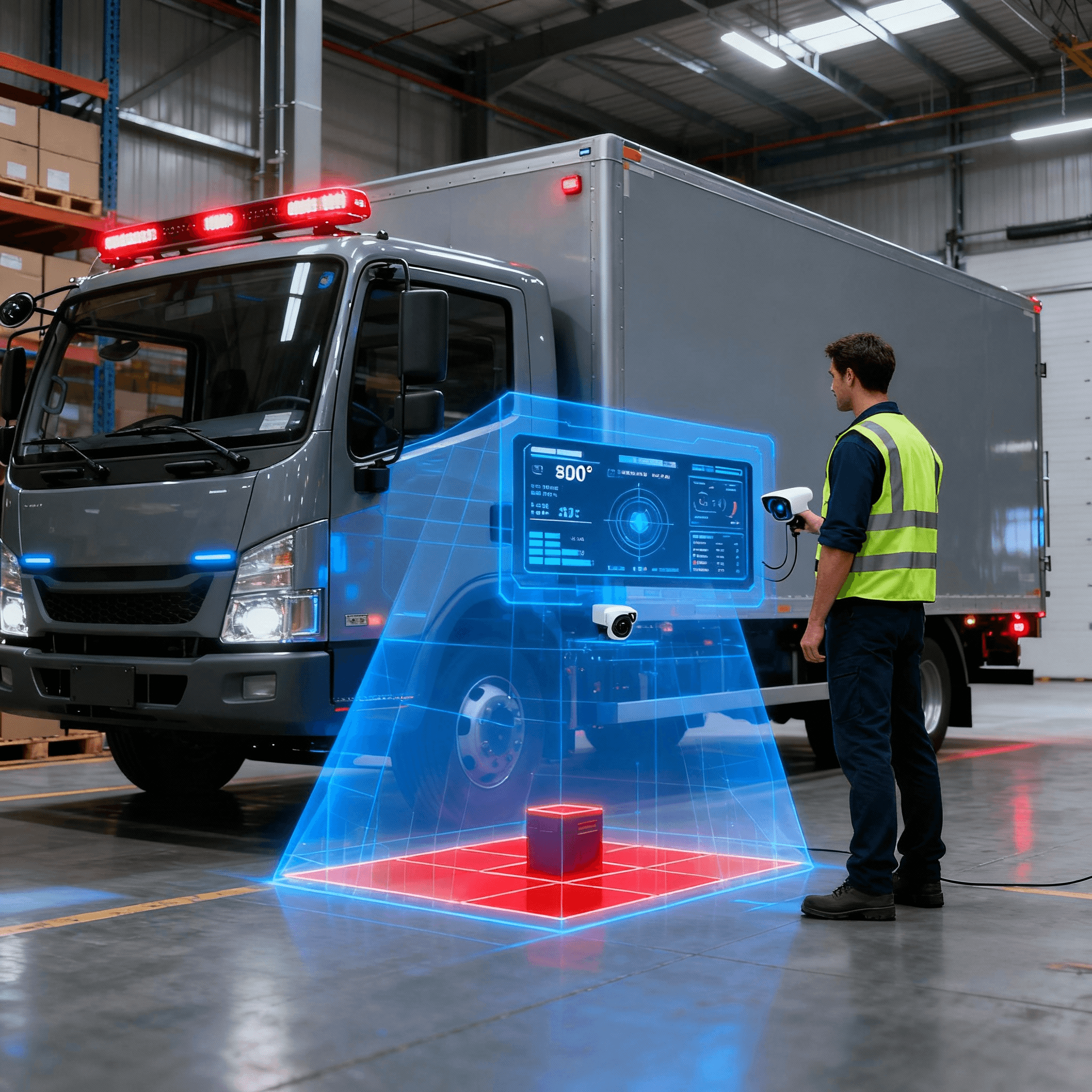Can AI Improve Worker Safety in Warehouses and on the Road?
Friday, 3 Oct 2025
|
As logistics companies strive to improve efficiency, reduce costs, and enhance customer satisfaction, the safety of workers—both in warehouses and on the road—should remain a top priority. This is especially crucial in industries like transportation and warehousing, where heavy machinery, long hours, and high-stakes operations put employees at risk.
But how can Artificial Intelligence (AI) help ensure that workers remain safe, secure, and productive? From autonomous vehicles on the road to smart safety systems in warehouses, AI is emerging as a game-changer for worker safety in logistics.
Let’s delve into how AI is improving safety for workers in logistics and explore some real-world examples of how this technology is making a tangible impact.
1. AI-Driven Warehouse Safety: Automation Meets Protection
Warehouses are bustling hubs of activity, with workers constantly moving goods, operating heavy machinery, and interacting with automated systems. In this high-paced environment, the risk of accidents—ranging from falls to collisions—is significant. AI is revolutionizing warehouse safety by implementing predictive tools, advanced monitoring systems, and automated processes that reduce human error and improve oversight.
AI-Powered Sensors and Wearables:
AI can use sensors and wearable devices to monitor workers in real time. For example, AI can detect hazardous situations, such as unsafe lifting practices or proximity to heavy machinery, and alert workers or supervisors immediately. In addition, wearables that track fatigue levels and physical strain can notify supervisors when a worker might be at risk of injury, allowing for early intervention.
Robotics and Automation:
By introducing robots into the warehouse, AI can take over dangerous tasks, such as lifting heavy items or working in hazardous environments, reducing the risk to human workers. Automated guided vehicles (AGVs) are becoming increasingly common, and AI ensures they navigate the warehouse floor safely, avoiding collisions with workers and other obstacles.
Real-World Example: Companies like Amazon are already using AI-powered robots in their fulfillment centers to assist with inventory management, reducing the risk of human injuries. AI algorithms continuously analyze data from the warehouse floor, ensuring that robots and human workers can coexist safely.
2. AI Enhances Road Safety for Drivers
For logistics companies that rely on transportation, road safety is a top priority. AI is playing a crucial role in enhancing road safety by providing real-time assistance to drivers, predicting potential hazards, and even enabling autonomous vehicles to reduce human error.
AI-Powered Driver Assistance Systems:
Advanced Driver Assistance Systems (ADAS), powered by AI, are improving road safety for truck drivers. These systems use cameras, sensors, and machine learning algorithms to detect obstacles, alert drivers to potential collisions, and even take corrective actions if needed. For example, AI can prevent accidents caused by driver fatigue by monitoring behavior and issuing alerts when signs of drowsiness or distraction are detected.
Autonomous Vehicles:
Self-driving trucks are the future of transportation, and AI is at the core of this revolution. These autonomous vehicles use AI to navigate roads safely, recognize road signs, and respond to changing traffic conditions in real-time. By removing the human element from the equation, autonomous trucks have the potential to reduce accidents caused by human error, such as fatigue, distractions, and impaired driving.
Real-World Example: Waymo, a leader in autonomous vehicle technology, has developed AI-powered self-driving trucks that can safely navigate highways, reducing the risk of accidents caused by human drivers. These vehicles are equipped with sensors that continuously scan the environment and make real-time decisions to ensure safe travel.
3. Predictive Maintenance: Proactively Preventing Accidents
Whether in warehouses or on the road, machinery and equipment failures are a significant risk factor for worker safety. AI is enabling predictive maintenance, where AI-driven algorithms monitor equipment health and predict potential failures before they happen.
In Warehouses:
AI can monitor machinery such as forklifts, conveyors, and automated systems. By using data from sensors, AI can detect early warning signs of wear and tear, ensuring that maintenance is carried out proactively before any failure occurs. This minimizes downtime, reduces accidents caused by malfunctioning equipment, and improves overall safety.
On the Road:
AI is also improving vehicle maintenance by monitoring the health of truck engines, brakes, tires, and other critical components. By collecting and analyzing data from IoT sensors embedded in vehicles, AI systems can predict when maintenance is needed, ensuring that trucks are always in optimal working condition, thus preventing accidents caused by mechanical failures.
Real-World Example: Volvo Trucks uses AI-based predictive maintenance tools to monitor vehicle health and alert fleet managers when a part is likely to fail. This helps avoid unexpected breakdowns, reducing the risk of accidents caused by equipment malfunctions.
4. Training and Safety Protocols Enhanced by AI
Proper training is essential to ensure that workers follow safety protocols and handle equipment safely. AI is improving the effectiveness of training programs, making them more personalized and engaging.
Virtual Reality (VR) Training:
AI-powered VR simulations are becoming increasingly popular in logistics training programs. These simulations allow workers to experience dangerous scenarios in a safe, controlled environment. From operating heavy machinery to managing emergency situations, VR training powered by AI provides realistic, hands-on experience, ensuring that workers are better prepared for real-world challenges.
AI for Continuous Safety Monitoring:
AI is also being used to track employee performance and safety compliance. By analyzing data from training programs and real-time behavior on the job, AI can identify areas where workers need further training or improvement, ensuring that safety protocols are consistently followed.
Real-World Example: DHL uses VR training powered by AI to simulate hazardous situations in the warehouse, enabling employees to learn how to respond to emergencies without the risk of actual injury.
5. AI-Driven Safety Culture: Encouraging a Proactive Approach
AI not only improves physical safety but also fosters a culture of safety within organizations. By providing data-driven insights, AI helps companies identify patterns and trends in workplace safety, allowing them to implement preventive measures effectively.
Data-Driven Safety Analytics:
AI systems collect vast amounts of data on safety incidents, near-misses, and operational inefficiencies. By analyzing this data, AI can identify patterns, predict potential safety risks, and recommend proactive measures to reduce incidents. This empowers management to take a more strategic and informed approach to safety.
Conclusion: A Safer Future with AI in Logistics
AI is undeniably transforming worker safety across the logistics industry, from warehouses to road transport. By automating high-risk tasks, providing real-time assistance, predicting equipment failures, and improving training programs, AI is reducing accidents and ensuring a safer working environment for all employees.
For CEOs, CXOs, and COOs, investing in AI-driven safety solutions is not just a smart business decision—it’s an essential move toward creating a safer, more efficient logistics operation. As the industry continues to evolve, the role of AI in ensuring worker safety will only grow more critical.
See How AI Can Improve Safety in Your Logistics Operations
Want to enhance safety and efficiency in your logistics operation? Book a demo today to discover how Debales AI can help streamline your warehouse and road safety processes.
Also, explore our related insights on AI’s role in logistics through blogs like AI-Powered Circular Supply Chains: Sustainability Meets Smart Logistics and How Predictive Analytics Works for Logistics: Driving Smarter Supply Chains.
All blog posts
View All →
Friday, 28 Nov 2025
The 90-Day Roadmap: Moving from Ad-Hoc AI to Operational Excellence
Stuck in AI experimentation? Learn how to escape Level 2 maturity using the Mess-O-Meter to diagnose chaos, prioritize with triangulation, and scale in 90 days.

Thursday, 27 Nov 2025
Mess-O-Meter Deep Dive: Real Logistics Examples for Digital Maturity
Discover Mess-O-Meter examples diagnosing digital chaos in logistics—baseline workflows, benchmark maturity, create AI roadmaps with real steps for transformation success.

Wednesday, 26 Nov 2025
Multi-Agent AI via Email: End-to-End Automation for Logistics Complexity
Explore agentic orchestration where autonomous email AI agents coordinate freight, customs, insurance, and carriers—automating multi-party processes for resilient supply chains.